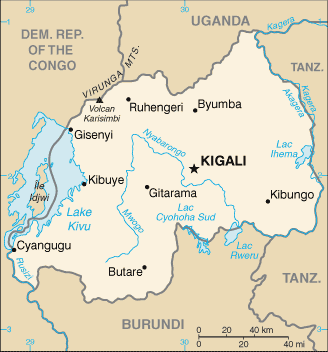|
Rwanda
|

|
Capital: Kigali
Population: 12,626,950
Brief History of Rwanda:
Rwanda has been inhabited by tribal peoples for thousands of years. In the 1400s a monarchy arose in the country lead by a Tutsi King. They called the king the mwami. There were two distinct classes of people, the Tutsi and the Hutu. The Tutsi were the royalty, while the Hutu were the lower class. Tutsi lords owned the land while Hutu farmers worked the land. In 1894, a German named Count Von Goetzen was the first European to visit Rwanda. In 1899 the Rwanda mwami kings agreed to become a German protectorate state. A few years later in 1915, Belgium took control of the country.
In 1959, a Hutu revolution overthrew the Tutsi monarchy and came into power. Over the next several years things were not good for the Tutsis. Many were killed and many more fled the country. In 1990 there was a civil war between the two groups and things got even worse until 1994 when a horrible thing happened. The government, led by the Hutus tried to kill all of the Tutsi people. This is called genocide. Over 800,000 Tutsi people were killed and millions fled the country.
The Geography of Rwanda
Total Size: 26,338 square km
Size Comparison: slightly smaller than Maryland
Geographical Coordinates: 2 00 S, 30 00 E
World Region or Continent: Africa
General Terrain: mostly grassy uplands and hills; relief is mountainous with altitude declining from west to east
Geographical Low Point: Rusizi River 950 m
Geographical High Point: Volcan Karisimbi 4,519 m
Climate: temperate; two rainy seasons (February to April, November to January); mild in mountains with frost and snow possible
Major cities: KIGALI (capital) 909,000 (2009)
The People of Rwanda
Type of Government: republic; presidential, multiparty system
Languages Spoken: Kinyarwanda (official) universal Bantu vernacular, French (official), English (official), Kiswahili (Swahili) used in commercial centers
Independence: 1 July 1962 (from Belgium-administered UN trusteeship)
National Holiday: Independence Day, 1 July (1962)
Nationality: Rwandan(s)
Religions: Roman Catholic 56.5%, Protestant 26%, Adventist 11.1%, Muslim 4.6%, indigenous beliefs 0.1%, none 1.7% (2001)
National Symbol:
National Anthem or Song: Rwanda nziza (Rwanda, Our Beautiful Country)
Economy of Rwanda
Major Industries: cement, agricultural products, small-scale beverages, soap, furniture, shoes, plastic goods, textiles, cigarettes
Agricultural Products: coffee, tea, pyrethrum (insecticide made from chrysanthemums), bananas, beans, sorghum, potatoes; livestock
Natural Resources: gold, cassiterite (tin ore), wolframite (tungsten ore), methane, hydropower, arable land
Major Exports: coffee, tea, hides, tin ore
Major Imports: foodstuffs, machinery and equipment, steel, petroleum products, cement and construction material
Currency: Rwandan franc (RWF)
National GDP: $13,620,000,000
** Source for population (2012 est.) and GDP (2011 est.) is CIA World Factbook.
Back to Geography Home Page
